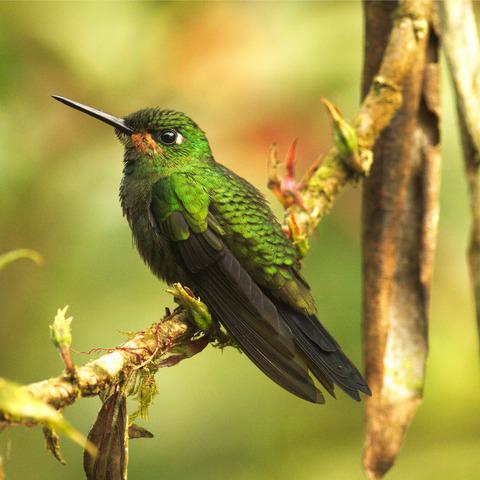当前位置:
X-MOL 学术
›
Funct. Ecol.
›
论文详情
Our official English website, www.x-mol.net, welcomes your
feedback! (Note: you will need to create a separate account there.)
The influence of biogeographical and evolutionary histories on morphological trait‐matching and resource specialization in mutualistic hummingbird–plant networks
Functional Ecology ( IF 4.6 ) Pub Date : 2021-03-02 , DOI: 10.1111/1365-2435.13784 Bo Dalsgaard 1 , Pietro Kiyoshi Maruyama 2 , Jesper Sonne 1, 3 , Katrine Hansen 1 , Thais B. Zanata 4 , Stefan Abrahamczyk 5 , Ruben Alarcón 6 , Andréa C. Araujo 7 , Francielle P. Araújo 8 , Silvana Buzato 9 , Edgar Chávez‐González 10 , Aline G. Coelho 11 , Peter A. Cotton 12 , Román Díaz‐Valenzuela 10 , Maria F. Dufke 1 , Paula L. Enríquez 13 , Manoel Martins Dias Filho 14 , Erich Fischer 7 , Glauco Kohler 15 , Carlos Lara 16 , Flor Maria G. Las‐Casas 17 , Liliana Rosero Lasprilla 18 , Adriana O. Machado 19 , Caio G. Machado 11 , María A. Maglianesi 20 , Tiago S. Malucelli 21 , Oscar H. Marín‐Gómez 22 , Vanessa Martínez‐García 10 , Severino Mendes de Azevedo‐Júnior 17 , Edvaldo Nunes da Silva Neto 14 , Paulo E. Oliveira 19 , Juan Francisco Ornelas 23 , Raul Ortiz‐Pulido 10 , Ruth Partida‐Lara 13 , Blanca Itzel Patiño‐González 10 , Steffani Najara de Pinho Queiroz 24 , Mónica B. Ramírez‐Burbano 25 , André Rech 24 , Márcia A. Rocca 26 , Licléia C. Rodrigues 27 , Ana M. Rui 28 , Ivan Sazima 29 , Marlies Sazima 30 , Benno I. Simmons 31 , Boris A. Tinoco 32 , Isabela G. Varassin 21 , Marcelo F. Vasconcelos 33 , Jeferson Vizentin‐Bugoni 34 , Stella Watts 35 , Jonathan D. Kennedy 36 , Carsten Rahbek 1, 3, 37, 38, 39 , Matthias Schleuning 40 , Ana M. Martín González 41
中文翻译:

生物地理和进化史对互惠蜂鸟-植物网络中形态特征匹配和资源专业化的影响
更新日期:2021-05-07
Functional Ecology ( IF 4.6 ) Pub Date : 2021-03-02 , DOI: 10.1111/1365-2435.13784 Bo Dalsgaard 1 , Pietro Kiyoshi Maruyama 2 , Jesper Sonne 1, 3 , Katrine Hansen 1 , Thais B. Zanata 4 , Stefan Abrahamczyk 5 , Ruben Alarcón 6 , Andréa C. Araujo 7 , Francielle P. Araújo 8 , Silvana Buzato 9 , Edgar Chávez‐González 10 , Aline G. Coelho 11 , Peter A. Cotton 12 , Román Díaz‐Valenzuela 10 , Maria F. Dufke 1 , Paula L. Enríquez 13 , Manoel Martins Dias Filho 14 , Erich Fischer 7 , Glauco Kohler 15 , Carlos Lara 16 , Flor Maria G. Las‐Casas 17 , Liliana Rosero Lasprilla 18 , Adriana O. Machado 19 , Caio G. Machado 11 , María A. Maglianesi 20 , Tiago S. Malucelli 21 , Oscar H. Marín‐Gómez 22 , Vanessa Martínez‐García 10 , Severino Mendes de Azevedo‐Júnior 17 , Edvaldo Nunes da Silva Neto 14 , Paulo E. Oliveira 19 , Juan Francisco Ornelas 23 , Raul Ortiz‐Pulido 10 , Ruth Partida‐Lara 13 , Blanca Itzel Patiño‐González 10 , Steffani Najara de Pinho Queiroz 24 , Mónica B. Ramírez‐Burbano 25 , André Rech 24 , Márcia A. Rocca 26 , Licléia C. Rodrigues 27 , Ana M. Rui 28 , Ivan Sazima 29 , Marlies Sazima 30 , Benno I. Simmons 31 , Boris A. Tinoco 32 , Isabela G. Varassin 21 , Marcelo F. Vasconcelos 33 , Jeferson Vizentin‐Bugoni 34 , Stella Watts 35 , Jonathan D. Kennedy 36 , Carsten Rahbek 1, 3, 37, 38, 39 , Matthias Schleuning 40 , Ana M. Martín González 41
Affiliation

|
- Functional traits can determine pairwise species interactions, such as those between plants and pollinators. However, the effects of biogeography and evolutionary history on trait‐matching and trait‐mediated resource specialization remain poorly understood.
- We compiled a database of 93 mutualistic hummingbird–plant networks (including 181 hummingbird and 1,256 plant species), complemented by morphological measures of hummingbird bill and floral corolla length. We divided the hummingbirds into their principal clades and used knowledge on hummingbird biogeography to divide the networks into four biogeographical regions: Lowland South America, Andes, North & Central America, and the Caribbean islands. We then tested: (a) whether hummingbird clades and biogeographical regions differ in hummingbird bill length, corolla length of visited flowers and resource specialization, and (b) whether hummingbirds' bill length correlates with the corolla length of their food plants and with their level of resource specialization.
- Hummingbird clades dominated by long‐billed species generally visited longer flowers and were the most exclusive in their resource use. Bill and corolla length and the degree of resource specialization were similar across mainland regions, but the Caribbean islands had shorter flowers and hummingbirds with more generalized interaction niches. Bill and corolla length correlated in all regions and most clades, that is, trait‐matching was a recurrent phenomenon in hummingbird–plant associations. In contrast, bill length did not generally mediate resource specialization, as bill length was only weakly correlated with resource specialization within one hummingbird clade (Brilliants) and in the regions of Lowland South America and the Andes in which plants and hummingbirds have a long co‐evolutionary history. Supplementary analyses including bill curvature confirmed that bill morphology (length and curvature) does not in general predict resource specialization.
- These results demonstrate how biogeographical and evolutionary histories can modulate the effects of functional traits on species interactions, and that traits better predict functional groups of interaction partners (i.e. trait‐matching) than resource specialization. These findings reveal that functional traits have great potential, but also key limitations, as a tool for developing more mechanistic approaches in community ecology.
中文翻译:

生物地理和进化史对互惠蜂鸟-植物网络中形态特征匹配和资源专业化的影响
- 功能性状可以决定成对的物种相互作用,例如植物和授粉媒介之间的相互作用。然而,生物地理学和进化史对特质匹配和特质介导的资源专业化的影响仍然知之甚少。
- 我们建立了一个数据库,该数据库包含93种互惠的蜂鸟-植物网络(包括181个蜂鸟和1,256种植物),并辅之以蜂鸟比尔和花冠长度的形态学测量。我们将蜂鸟划分为其主要进化枝,并利用有关蜂鸟生物地理学的知识将网络划分为四个生物地理区域:南美低地,安第斯山脉,北美和中美洲以及加勒比海岛屿。然后我们进行了以下测试:(a)蜂鸟的进化枝和生物地理区域在蜂鸟的帐单长度,探访花的花冠长度和资源专业化方面是否有所不同,以及(b)蜂鸟的帐单长度是否与食用植物的花冠长度及其水平相关资源专业化。
- 以长嘴鸟为主的蜂鸟进化枝通常会见到更长的花朵,并且在资源利用方面是最独特的。在整个大陆地区,比尔和花冠的长度和资源的专业化程度相似,但是加勒比海岛屿的花和蜂鸟较短,互动生态位更广泛。比尔和花冠的长度在所有地区和大多数进化枝上都相关,也就是说,性状匹配是蜂鸟与植物之间的一种关联现象。相比之下,账单长度通常不介导资源专业化,因为账单长度仅与一个蜂鸟进化枝(Brilliants)以及南美洲低地和安第斯山脉地区的资源专业化相关程度较弱,在这些地区植物和蜂鸟的合作关系很长。进化史。
- 这些结果证明了生物地理和进化史如何调节功能性状对物种相互作用的影响,并且与资源专业化相比,性状更好地预测了相互作用伙伴的功能组(即性状匹配)。这些发现表明,作为开发社区生态学中更多机械方法的工具,功能性状具有巨大的潜力,但也有关键的局限性。









































 京公网安备 11010802027423号
京公网安备 11010802027423号